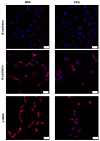Delivery of Protein Kinase A by CRISPRMAX and Its Effects on Breast Cancer Stem-Like Properties
- PMID: 33374889
- PMCID: PMC7824330
- DOI: 10.3390/pharmaceutics13010011
Delivery of Protein Kinase A by CRISPRMAX and Its Effects on Breast Cancer Stem-Like Properties
Abstract
Protein kinase A (PKA) activation has recently been reported to inhibit epithelial-mesenchymal transition (EMT) and cancer stem cell (CSC) ability, which is considered to be responsible for chemoresistance and tumor recurrence in patients. While current studies mainly focus on gene manipulation of the EMT process, the direct delivery of PKA enzymes to cancer cells has never been investigated. Here, we utilize the commercial Lipofectamine CRISPRMAX reagent to directly deliver PKAs to breast cancer cells and evaluate its effects on EMT regulation. We optimized the delivery parameters with fluorescent-labeled bovine serum albumin, and successfully delivered fluorescent PKAs through CRISPRMAX into breast cancer cells. Then, we evaluated the biological effects by immunofluorescence, flow cytometry, mammosphere assay, and chemoresistance assay. Our data showed the expression of EMT-related markers, α-smooth muscle actin and N-cadherin, was downregulated after CRISPRMAX-PKA treatment. Although the CD44+/CD24- population did not change considerably, the size of mammospheres significantly decreased. In paclitaxel and doxorubicin chemoresistance assays, we noticed PKA delivery significantly inhibited paclitaxel resistance rather than doxorubicin resistance. Taken together, these results suggest our direct enzyme delivery can be a potential strategy for inhibiting EMT/CSC-associated traits, providing a safer approach and having more clinical translational efficacy than gene manipulation. This strategy will also facilitate the direct testing of other target enzymes/proteins on their biological functions.
Keywords: CRISPRMAX; cancer stem cells; chemoresistance; drug delivery; epithelial-mesenchymal transition; protein kinase A.
Conflict of interest statement
The authors declare no conflict of interest.
Figures










Similar articles
-
Anti-metastasis activity of curcumin against breast cancer via the inhibition of stem cell-like properties and EMT.Phytomedicine. 2019 May;58:152740. doi: 10.1016/j.phymed.2018.11.001. Epub 2018 Nov 12. Phytomedicine. 2019. PMID: 31005718
-
SLUG/SNAI2 and tumor necrosis factor generate breast cells with CD44+/CD24- phenotype.BMC Cancer. 2010 Aug 6;10:411. doi: 10.1186/1471-2407-10-411. BMC Cancer. 2010. PMID: 20691079 Free PMC article.
-
ZEB1 potentiates chemoresistance in breast cancer stem cells by evading apoptosis.Biochim Biophys Acta Mol Cell Res. 2023 Oct;1870(7):119528. doi: 10.1016/j.bbamcr.2023.119528. Epub 2023 Jun 23. Biochim Biophys Acta Mol Cell Res. 2023. PMID: 37356459
-
Effect of Melatonin in Epithelial Mesenchymal Transition Markers and Invasive Properties of Breast Cancer Stem Cells of Canine and Human Cell Lines.PLoS One. 2016 Mar 2;11(3):e0150407. doi: 10.1371/journal.pone.0150407. eCollection 2016. PLoS One. 2016. PMID: 26934679 Free PMC article.
-
Communication Between Epithelial-Mesenchymal Plasticity and Cancer Stem Cells: New Insights Into Cancer Progression.Front Oncol. 2021 Apr 21;11:617597. doi: 10.3389/fonc.2021.617597. eCollection 2021. Front Oncol. 2021. PMID: 33968721 Free PMC article. Review.
Cited by
-
Production of Genetically Modified Porcine Embryos via Lipofection of Zona-Pellucida-Intact Oocytes Using the CRISPR/Cas9 System.Animals (Basel). 2023 Jan 18;13(3):342. doi: 10.3390/ani13030342. Animals (Basel). 2023. PMID: 36766231 Free PMC article.
-
Biomineralize Mitochondria in Metal-Organic Frameworks to Promote Mitochondria Transplantation From Non-Tumorigenic Cells Into Cancer Cells.Smart Med. 2025 Feb 26;4(1):e134. doi: 10.1002/smmd.134. eCollection 2025 Mar. Smart Med. 2025. PMID: 40059964 Free PMC article.
References
Grants and funding
LinkOut - more resources
Full Text Sources
Research Materials
Miscellaneous

